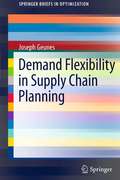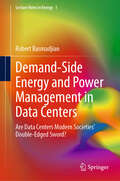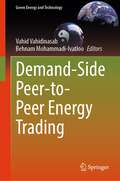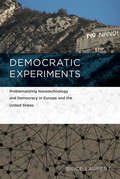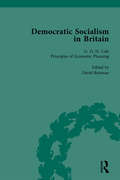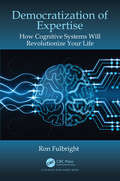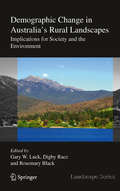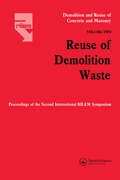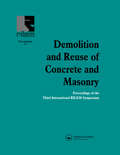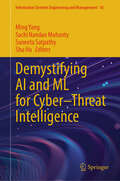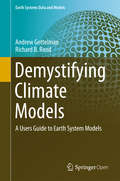- Table View
- List View
Demand Driven Supply Chain: A Structured and Practical Roadmap to Increase Profitability
by Paulo MendesThis book aims to identify and describe the practical key components of demand driven supply chains, and based on these components, develops a structured and integrated assessment framework that companies can use to assess their current and desired future supply chain states in light of the Demand Driven Supply Chain (DDSC) concepts. Another contribution of the book is the structured framework developed to design a supply chain strategy, which will consider the DDSC assessment results as one of the key inputs, and will support the implementation of the opportunities identified during the assessment. The framework presented in this book was applied in different supply chain operations of a global CPG company to validate the methodology and formalize an action plan to allow these operations move towards a DDSC. Results show clear opportunities to improve supply chain operation and become more demand driven.
Demand Flexibility in Supply Chain Planning
by Joseph GeunesThis work encapsulates the essential developments in this field into a single resource, as well as to set an agenda for further development in the field. This brief focuses on the demand flexibility in supply chains with fragmented results distributed throughout the literature. These results have strong implications for managing real-world complex operations planning problems. This book exploits dimensions of demand flexibility in supply chains and characterizes the best fit between demand properties and operations capabilities and constraints. The origins and seminal works are traced in integrated demand and operations planning and an in-depth documentation is provided for the current state of the art. Systems with inherent costs and constraints that must respond to some set of demands at a minimum cost are examined. Crucial unanswered questions are explored and the high-value research directions are highlighted for both practice and for the development of new and interesting optimization models and algorithms.
Demand Response Application in Smart Grids: Concepts and Planning Issues - Volume 1
by Sayyad Nojavan Kazem ZareThis book analyzes the economic and technical effects of demand response programs in smart grids. A variety of operational and financial benefits are offered by demand response programs (DRPs) for load-serving entities, grid operators, and electricity consumers. The most notable advantages of DRPs are presented in this book, including decreased electricity prices, risk management, market power mitigation, and flexibility of market operations. In-depth chapters discuss the integration of demand response programs for the planning and operation of smart grids and explore the uncertainties of market prices, renewable resources and intermittent load management, making this a useful reference for a variety of different organizations and players in the electricity market, such as reliability organizations, distribution companies, transmission companies, and electric end-users.
Demand Response Application in Smart Grids: Operation Issues - Volume 2
by Sayyad Nojavan Kazem ZareThis book analyzes issues surrounding the efficient integration of demand response programs (DRPs) on operation problems in smart grids. The benefits offered by demand response programs (DRPs) for load-serving entities, grid operators, and electricity consumers are explained, including decreased electricity prices and risk management. In-depth chapters discuss the flexibility of market operations, market power mitigation, and environmental benefits—making this a must-have reference for engineers and related practicing professionals working for organizations in the electricity market, including reliability organizations, distribution companies, transmission companies, and electric end-users.
Demand Response in Smart Grids
by Ning Lu Pengwei Du Haiwang ZhongThis book is the first of its kind to comprehensively describe the principles of demand response. This allows consumers to play a significant role in the operation of the electric grid by reducing or shifting their electricity usage in response to the grid reliability need, time-based rates or other forms of financial incentives. The main contents of the book include modeling of demand response resources, incentive design, scheduling and dispatch algorithms, and impacts on grid operation and planning. Through case studies and illustrative examples, the authors highlight and compare the advantages, disadvantages and benefits that demand response can have on grid operations and electricity market efficiency.First book of its kind to introduce the principles of demand response;Combines theory with real-world applications useful for both professionals and academic researchers;Covers demand response in the context of power system applications.
Demand Response in Smart Microgrids: Advanced and Optimal Energy Management Strategies (Studies in Systems, Decision and Control #619)
by Mohammed Ouassaid Rajaa Naji El Idrissi Meryeme AzaroualThis book covers the optimization of the energy flow management of a grid-tied photovoltaic-wind-battery energy storage system and the development of demand response algorithms for a single customer at the lowest level and extended it to a large community of participants at the highest level. Hence, this book consists of two parts. The first part is devoted to the design of energy management strategies for a residential PV-WT system, while considering time of use and feed in tariff schemes. Further, the developed management algorithms mitigate the greenhouse gas emissions. Additionally, a closed-loop control based-model predictive control scheme, to forecast the system behavior and deal with renewable energy resources and load disturbances, is elaborated. The second part is dedicated to developing effective demand side management techniques and cooperative energy scheduling in the framework of collective smart-buildings. Cooperative energy scheduling programs are designed while considering three objectives: minimizing peak load, minimizing electricity cost, and avoiding the occurrence of rebound peaks. Optimal consumption decisions are examined in residential, commercial, and industrial areas. Besides, the impact of electric vehicle charging methods is investigated for different EV penetration levels. Also, a game theory approach for energy consumption scheduling of a community of smart microgrids is built. In summary, this book successfully establishes the important synergy between microgrid energy management and demand response at the level of a smart home and an aggregated building community. The above aspects are illustrated in this book in 12 chapters. The scope is broad. This book chapters are very effective in theoretical analysis and design of optimization algorithms in the realm of smart grids. This book is intended to provide advanced undergraduate, graduate students, engineers, researchers on energy management within smart homes and clustered buildings, with a comprehensive understanding of various methods and designed algorithms. These strategies and algorithms aim to deal with defies ranging from augmented adoption of microgrids to the introduction of demand response approaches, to enhance the grid viability and resilience.
Demand-Side Energy and Power Management in Data Centers: Are Data Centers Modern Societies’ Double-Edged Sword? (Lecture Notes in Energy #1)
by Robert BasmadjianThis book explains the principles, foundations and methodologies adopted in data centers to achieve demand-side energy and peak power management. It gives a brief introduction about Smart Grid, how the transition from legacy to Smart Grid is realized, the different approaches for demand-side management (DSM), and then discusses the opportunities of data centers to achieve DSM and highlight the different considered optimization criterion. Data centers are the backbones in realizing digitization where they host ICT (information and communication technologies) resources like servers, storage devices and networking equipment. Despite their advantages in terms of providing numerous services to our modern society (e.g. social media, e-commerce, online learning), the major drawback is that data centers devour enormous amounts of energy. It is expected that the energy usage of data centers will increase in the next few years - expected to reach almost 25% of the world's overall consumption - due to the emerging and expanding technologies such as Blockchain and 5G.
Demand-Side Peer-to-Peer Energy Trading (Green Energy and Technology)
by Behnam Mohammadi-Ivatloo Vahid VahidinasabDemand-Side Peer-to-Peer Energy Trading provides a comprehensive study of the latest developments in technology, protocols, implementation, and application of peer-to-peer and transactive energy concepts in energy systems and their role in worldwide energy evolution and decarbonization efforts. It presents practical aspects and approaches with evidence from applications to real-world energy systems through in-depth technical discussions, use cases, and examples. This multidisciplinary reference is suitable for researchers and industry stakeholders who focus on the field of energy systems and energy economics, as well as researchers and developers from different branches of engineering, energy, computer sciences, data, economic, and operation research fields.
Demand-side Flexibility in Smart Grid (SpringerBriefs in Applied Sciences and Technology)
by Aydin Azizi Roya Ahmadiahangar Argo Rosin Ivo PaluThis book highlights recent advances in the identification, prediction and exploitation of demand side (DS) flexibility and investigates new methods of predicting DS flexibility at various different power system (PS) levels. Renewable energy sources (RES) are characterized by volatile, partially unpredictable and mostly non-dispatchable generation. The main challenge in terms of integrating RES into power systems is their intermittency, which negatively affects the power balance. Addressing this challenge requires an increase in the available PS flexibility, which in turn requires accurate estimation of the available flexibility on the DS and aggregation solutions at the system level. This book discusses these issues and presents solutions for effectively tackling them.
Demanding Energy: Space, Time and Change
by Gordon Walker Allison Hui Rosie DayThis edited collection critically engages with an important but rarely-asked question: what is energy for? This starting point foregrounds the diverse social processes implicated in the making of energy demand and how these change over time to shape the past patterns, present dynamics and future trajectories of energy use. Through a series of innovative case studies, the book explores how energy demand is embedded in shared practices and activities within society, such as going to music festivals, cooking food, travelling for business or leisure and working in hospitals. Demanding Energy investigates the dynamics of energy demand in organisations and everyday life, and demonstrates how an understanding of spatiality and temporality is crucial for grasping the relationship between energy demand and everyday practices. This collection will be of interest to researchers and students in the fields of energy, climate change, transport, sustainability and sociologies and geographies of consumption and environment. Chapters 1 and 15 of this book are available open access under a CC BY 4.0 license at link.springer.com
Dementia Lab 2021: Proceedings of the 5th Dementia Lab Conference, D-Lab 2021, January 18–28, 2021 (Design For Inclusion #2)
by Rens Brankaert Caylee Raber Maarten Houben Paulina Malcolm Jon HannanThis book gathers revised and selected contributions to the 5th Dementia Lab Conference, D-Lab 2021, organized online on January 18-28, 2021, from the Emily Carr University of Art + Design, Vancouver, Canada. It describes original strategies in which design or creative methods have been shown to uncover, support and enhance the abilities of people living with dementia. Papers report on new ideas and findings relating to three main themes: engagement, empowerment and identity. They cover: ethics of inclusion and solutions for shifting the culture of care to be focused on both personal independence and reconnecting with the community; new ways of designing with people living with dementia; strategies for breaking negative stereotypes and preconceived opinions; and approaches to retaining personhood and dignity. Offering a timely source of information on new design and creative methods to a broad community of industrial, communication, interactive and inclusive designers, this book is also meant to address and inspire various stakeholders and organizations in dementia care.
Dementia Lab 2022: Proceedings of the 6th Dementia Lab Conference, D-Lab 2022, September 20–22, 2022, Leuven, Belgium (Design For Inclusion #3)
by Rens Brankaert Maarten Houben Niels Hendriks Andrea Wilkinson Kellie MorrisseyThis book gathers the revised and selected contributions to the 6th Dementia Lab Conference, D-Lab 2022, held on September 20-22, 2022, in Leuven. It describes original and innovative research on how design can contribute to the quality of life of people with dementia, their loved ones, and caregivers. The papers highlight the value of participation within design, analyzing it at three levels: personal, product, and organizational. The presented ideas and findings address ‘The Residue of Design’ and go beyond the initial impact of the design itself by looking at what benefits design research brings for people with dementia. The papers cover topics such as the development of creative design methods to foster participation and engagement from people with dementia, evaluation studies or critical reflections that reveal the impact of products and the built environment in dementia care, and raising awareness and countering stigma in societal views on dementia.
Democracy in Practice: Public Participation in Environmental Decisions
by Thomas C. BeierleIn spite of the expanding role of public participation in environmental decisionmaking, there has been little systematic examination of whether it has, to date, contributed toward better environmental management. Neither have there been extensive empirical studies to examine how participation processes can be made more effective. Democracy in Practice brings together, for the first time, the collected experience of 30 years of public involvement in environmental decisionmaking. Using data from 239 cases, the authors evaluate the success of public participation and the contextual and procedural factors that lead to it. Thomas Beierle and Jerry Cayford demonstrate that public participation has not only improved environmental policy, but it has also played an important educational role and has helped resolve the conflict and mistrust that often plague environmental issues. Among the authors' findings are that intensive 'problem-solving' processes are most effective for achieving a broad set of social goals, and participant motivation and agency responsiveness are key factors for success. Democracy in Practice will be useful for a broad range of interests. For researchers, it assembles the most comprehensive data set on the practice of public participation, and presents a systematic typology and evaluation framework. For policymakers, political leaders, and citizens, it provides concrete advice about what to expect from public participation, and how it can be made more effective. Democracy in Practice concludes with a systematic guide for use by government agencies in their efforts to design successful public participation efforts.
Democratic Experiments: Problematizing Nanotechnology and Democracy in Europe and the United States (Inside Technology)
by Brice LaurentAn examination of nanotechnology as a lens through which to study contemporary democracy in both theory and practice.In Democratic Experiments, Brice Laurent discusses the challenges that emerging technologies create for democracy today. He focuses on nanotechnology and its attendant problems, proposing nanotechnology as a lens through which to understand contemporary democracy in both theory and practice. Arguing that democracy is at stake where nanotechnology is defined as a problem, Laurent examines the sites where nanotechnology is discussed and debated by scientists, policymakers, and citizens. It is at these sites where the joint production of nanotechnology and the democratic order can be observed. Focusing on the United States, France, and Europe, and various international organizations, Laurent analyzes representations of nanotechnology in science museums, collective discussions in participatory settings, the making of categories such as “nanomaterials” or responsible innovation” in standardization and regulatory arenas, and initiatives undertaken by social movements. He contrasts American debates, in which the concern for public objectivity is central, with the French “state experiment,” the European goal of harmonization, and the international concern with a global market. In France, public debate proceeded in response to public protest and encountered a radical critique of technological development; the United States experimented with an innovative approach to technology assessment. The European regulatory approach results in lengthy debates over political integration; the United States relies on the adversarial functioning of federal agencies. Because nanotechnology is a domain where concerns over anticipation and participation are pervasive, Laurent argues, nanotechnology—and science and technology studies more generally—provides a relevant focus for a renewed analysis of democracy.
Democratic Socialism in Britain, Vol. 2: Classic Texts in Economic and Political Thought, 1825-1952
by David ReismanThe texts in this collection of 10 volumes demonstrate both the diversity and continuity in British theories of democratic socialism. The selection encompasses the Ricardian socialists, the Christian socialists, and the Fabian socialists. Volume 2 includes contributions from .Frederick Denison, Maurice Charles Kingsley and John Malcolm Ludlow, the ‘Christian Socialists’.
Democratic Socialism in Britain, Vol. 7: Classic Texts in Economic and Political Thought, 1825-1952
by David ReismanThe texts in this collection of 10 volumes demonstrate both the diversity and continuity in British theories of democratic socialism. The selection encompasses the Ricardian socialists, the Christian socialists, and the Fabian socialists. Volume 7 includes ‘Principles of Economic Planning’ by G.D.H.Cole.
Democratization of Expertise: How Cognitive Systems Will Revolutionize Your Life
by Ron FulbrightWe create technology enabling us to do things never before possible and it ultimately changes the way we live, work, play, and interact with each other. Throughout human history, the democratization of technology making a technology available to the masses, has brought about sweeping cultural, social, political, and societal changes. In the last half-century, the democratization of computers, information, the Internet, and social media have revolutionized and transformed our lives. We now stand at the beginning of a new era sure to bring about waves of new revolutions, the cognitive systems era. Until now, humans have done all of the thinking. However, our lives are about to be infused with artificial entities capable of performing high-level cognitive processing previously possible only in the human mind. Systems capable of this kind of "synthetic cognition" will achieve and surpass the level of human experts in almost every field of endeavor. Far from replacing humans, these cognitive systems will be our collaborators, teachers, confidants, colleagues, and companions. The future will belong to those who can better partner with these cognitive systems. Made available to the average person via the Internet, handheld devices, and through ordinary objects all around us, expertise will become democratized. Everything will change when anyone has access to expertise in any field and new things will be possible. The democratization of expertise is the foundation on which our society’s revolutions will be built over the next half-century. This book discusses societal and cultural revolutions throughout history brought about by the adoption of new technology and gives brief histories of human cognitive augmentation and artificial intelligence. In the coming cognitive systems era, humans, by collaboratively partnering with cognitive systems, will together achieve expert-level performance—synthetic expertise—with humans performing some of the cognitive processing and cognitive systems performing some. As the capabilities of cognitive systems improve over time, the balance of thinking will shift from being mostly human to mostly artificial. This book introduces the Levels of Cognitive Augmentation to describe this shift. Drawing from previous research in cognitive systems and intelligent agent theory, the knowledge stores required for expertise are identified in a Knowledge Level description of expertise. This book introduces a new abstract level, called the Expertise Level to describe the skills needed for expertise. Combining the knowledge-level and expertise-level descriptions, this book introduces the Model of Expertise. This book demonstrates use of the Model of Expertise by presenting several synthetic expert architectures: a synthetic teacher (Synthia), a synthetic friend/therapist (Sy), a synthetic elderly companion (Lois), a synthetic research companion (Synclair), and an automated scientific hypothesis explorer (Ashe). This book is intended for anyone interested in the fields of cognitive systems, cognitive computing, cognitive augmentation, or artificial intelligence or the impact of technologies from these fields on society. Anyone doing research and development in the area of cognitive systems or artificial intelligence will find this book particularly useful.
Demographic Change in Australia's Rural Landscapes
by Rosemary Black Gary W. Luck Digby RaceThroughout history, humans have lived primarily in rural landscapes. In 2008, for the first time, the global population became predominantly urban. While much research has focussed on the impacts of increasing urbanisation, we have very little knowledge of the implications of these changes for rural landscapes. Global trends suggest populations in rural landscapes are, relatively speaking, in decline. Yet this broad trend is too simplistic and can be very misleading for researchers, land managers and policy makers. This generalisation often masks a much more complex and dynamic process of demographic change, with some rural areas increasing in popularity and experiencing new environmental pressures. The patterns of change can be broadly characterised in two ways: population decline and dissolving rural communities; and amenity-led in-migration (or counter-urbanisation) - a trend identified in developed regions such as North America and Australia. Both of these patterns have substantial implications for the management and sustainability of rural landscapes and communities. This book examines broad and local-scale patterns of demographic change in rural landscapes, identifying some of the drivers of these changes using local case studies, and outlining the implications of changes for society and the environment. The book adopts an interdisciplinary approach by explicitly linking demographic change with environmental, land-use, social and economic factors. The book will provide a useful resource for researchers and graduate students interested in urban development, sustainability science, landscape studies and demographic change, as well as environmental management, human and physical geography and rural sociology.
Demolition Methods and Practice V1
by Y. KasaiThis book contains papers, presented at the Second International RILEM Symposium on Demolition and Reuse of Concrete and Masonry, held in Tokyo, Japan, in November 1988, on various demolition techniques and practice as well as demolition machines of concrete structures.
Demolition Reuse Conc Mason V2
by Y KasaiThis book includes papers on demolition methods and practice and reuse of demolition waste, presented at RILEM symposium held in Japan. The papers contribute to the development of demolition and reuse of concrete and masonry structures.
Demolition and Reuse of Concrete and Masonry: Proceedings of the Third International RILEM Symposium
by Erik K. LauritzenThis book forms the Proceedings of the Third International RILEM Symposium in Odense, Demark in October 1993. It includes reviews and reports of recent developments in the fields of demolition techniques and reuse of waste building materials, and focusses on the integration of demolition and recycling operations in the construction and housing indu
Demystifying AI and ML for Cyber–Threat Intelligence (Information Systems Engineering and Management #43)
by Ming Yang Shu Hu Suneeta Satpathy Sachi Nandan MohantyThis book simplifies complex AI and ML concepts, making them accessible to security analysts, IT professionals, researchers, and decision-makers. Cyber threats have become increasingly sophisticated in the ever-evolving digital landscape, making traditional security measures insufficient to combat modern attacks. Artificial intelligence (AI) and machine learning (ML) have emerged as transformative tools in cybersecurity, enabling organizations to detect, prevent, and respond to threats with greater efficiency. This book is a comprehensive guide, bridging the gap between cybersecurity and AI/ML by offering clear, practical insights into their role in threat intelligence. Readers will gain a solid foundation in key AI and ML principles, including supervised and unsupervised learning, deep learning, and natural language processing (NLP) while exploring real-world applications such as intrusion detection, malware analysis, and fraud prevention. Through hands-on insights, case studies, and implementation strategies, it provides actionable knowledge for integrating AI-driven threat intelligence into security operations. Additionally, it examines emerging trends, ethical considerations, and the evolving role of AI in cybersecurity. Unlike overly technical manuals, this book balances theoretical concepts with practical applications, breaking down complex algorithms into actionable insights. Whether a seasoned professional or a beginner, readers will find this book an essential roadmap to navigating the future of cybersecurity in an AI-driven world. This book empowers its audience to stay ahead of cyber adversaries and embrace the next generation of intelligent threat detection.
Demystifying Climate Models: A Users Guide to Earth System Models (Earth Systems Data and Models #2)
by Andrew Gettelman Richard B. RoodThis book demystifies the models we use to simulate present and future climates, allowing readers to better understand how to use climate model results. In order to predict the future trajectory of the Earth’s climate, climate-system simulation models are necessary. When and how do we trust climate model predictions? The book offers a framework for answering this question. It provides readers with a basic primer on climate and climate change, and offers non-technical explanations for how climate models are constructed, why they are uncertain, and what level of confidence we should place in them. It presents current results and the key uncertainties concerning them. Uncertainty is not a weakness but understanding uncertainty is a strength and a key part of using any model, including climate models. Case studies of how climate model output has been used and how it might be used in the future are provided. The ultimate goal of this book is to promote a better understanding of the structure and uncertainties of climate models among users, including scientists, engineers and policymakers.
Den Ozean forschend entdecken: Experimente aus dem Lehr- und Lern-Labor Wattenmeer der Universität Oldenburg
by Corinna Hößle Holger Winkler Anja WübbenDer Ozean ist die Grundlage alles Lebendigen auf dieser Erde und stellt uns eine Vielzahl an Ressourcen zur Verfügung. Und doch ist dieses System massiv gefährdet durch die anthropogene Nutzung. In diesem Lehrwerk erfahren Sie anhand einfacher Experimente und gut strukturierter Anleitungen wichtige chemische, physikalische und biologische Hintergründe zum komplexen und empfindlichen System des Ozeans. Erstmals werden die mehrfach erprobten und optimierten Experimente eines Schülerlabors veröffentlicht, basierend auf langjähriger Zusammenarbeit von Meereswissenschaftler*innen und Fachdidaktiker*innen. Das Lehr- und Lernlabor Wattenmeer der Universität Oldenburg stellt hiermit allen Interessierten ihr fächerübergreifendes und fachdidaktisch reflektiertes Experimentierangebot zur Verfügung. Zusätzlich erhalten Sie Materialien zur Förderung des verantwortungsbewussten Urteilens und Handelns in Bezug auf die Ozeannutzung. Diese ermöglichen eine einfache Integration in den Unterricht und entfachen spannende Diskussionen. Sie werden in eine Methode eingeführt, die eine ethische Bewertung anthropogener Nutzungsweisen des Ozeans ermöglicht und dabei ökologische, soziale und ökonomische Aspekte berücksichtigt. Dabei werden Methoden zur Wertanalyse, Argumentationsweise und Folgenanalyse sowie zum Perspektivwechsel vorgestellt, die eine direkte praktische Umsetzung in unterschiedlichen Bildungseinrichtungen ermöglichen. Das Buch greift damit die Ziele der Bildung für eine nachhaltige Entwicklung konkret auf und bietet Ihnen viele wertvolle und sehr gut ausgearbeitete Möglichkeiten, diese am Beispiel des Themas Ozean in Ihrem Bildungsbereich handlungsorientiert umzusetzen. Nutzen Sie dieses umfassende Angebot, um relevante Themen in Ihrem Lehrplan zu integrieren.
Den Tätern auf der Spur
by Alexander DörsamAus dem Alltag eines digitalen Ersthelfers Der IT-Sicherheitsexperte Alexander Dörsam entführt Sie mit seinem Buch in die spannende Welt von Hacking, Unternehmenserpressung, Spionage und digitalem Vandalismus. Anhand von realen IT-Sicherheitsvorfällen erfahren Sie, wie Angreifer in Firmenstrukturen eindringen, welche Methoden dafür eingesetzt werden und welche Folgen das haben kann. Doch wie schütze ich mich oder mein Unternehmen? Was ist zu tun bei einem digitalen Notfall? Dörsam hilft Ihnen nicht selbst Opfer zu werden, zeigt das IT-Krisenmanagement und gibt Hinweise zur Ersthilfe bei IT-Sicherheitsvorfällen. Ein fesselndes Buch für alle, die mehr über aktuelle digitale Bedrohungen erfahren wollen.

